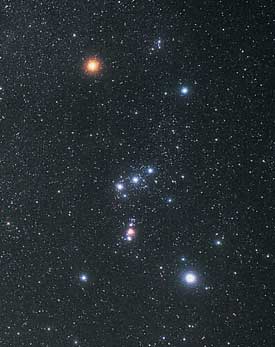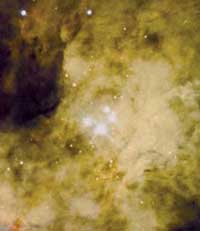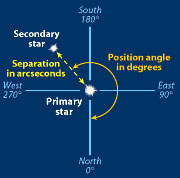
A symbol of the winter sky (summer sky south of the equator), Orion is home to many beautiful double stars and a few multiple-star systems. A dozen entries on the author's list can be found within the constellation's boundaries.
Courtesy Akira Fujii.
Double-star observing offers many attractions for amateur astronomers — light pollution, whether from man or Moon, has little impact on the image, and even a modest 3-inch telescope will show all the best doubles in the sky. In my opinion, a pretty double in a small scope is lovelier than a faint smudge of a galaxy in a giant light bucket.
Many amateurs enjoy the challenge of splitting very difficult (close) doubles. Occasionally I do too. But mostly I enjoy doubles simply for their beauty. After observing doubles for several years I have developed some criteria for choosing the most visually pleasing pairs or multiples, and contrasting color tops the list. The more contrast, the better. The well-known summer jewel Albireo (β Cygni), the gold and pale blue pair Almach (γ Andromedae), and the orange and blue suns of 24 Comae Berenices are the color-contrast leaders.

A close-up view of the Orion Nebula (M42). The four stars of the Trapezium are clearly visible.
Courtesy Lick Observatory.
Lacking distinctive hues, the prettiest pairs are those reasonably well matched in brightness. Castor (α Geminorum) is a particularly fine example of this. Stars with widely differing magnitudes just don't have the same visual appeal as a pair of twin suns blazing away in the eyepiece.
I also prefer double-star systems in which one of the stars is magnitude 6 or brighter. Dim doubles simply aren't as captivating and they're also harder to find.
Some Double Star Details
The list on the following page is my compilation of the prettiest doubles (and multiples) visible from the Northern and/or Southern Hemispheres when Orion is riding high in the sky. The list has a couple of novel columns: color difference and optimum magnification. The color-difference rating is the number of letters between stars on the well-known OBAFGKM scale of spectral classification. For example, Almach's components are B and K, so Almach rates a 4. (In "More Pretty Double Stars" I present 54 double or multiple stars visible during summer in the Northern Hemisphere.)

The two measures of a double star are separation and position angle. The directions shown here are for an inverting scope, such as a Newtonian reflector. Other telescopes may have different field orientations.
Sky & Telescope illustration.
I've found that doubles look their best at a magnification that is approximately 750 divided by the separation in arcseconds. For example, Eta (η) Cassiopeiae's components are separated by 12.5" — 750/12.5 yields an optimum magnification of 60x. Similarly, since the unaided eye can resolve stars as close as about 300", the minimum magnification for a split is 300 divided by the separation. In the case of Eta, that would be around 24x (300/12.5). Note that some of the stars on the list have optimum magnifications that fall within the range of binoculars.
It has been stated that the maximum magnification is about 50 times the aperture in inches. But you'll often benefit by going higher when viewing tight doubles. I begin by finding the star with my scope set at low power (which is also the maximum field of view). Then I work up to the optimum magnification.
The theoretical resolving limit of a high-quality telescope is about 5.5 divided by the telescope's aperture, in inches. But in all my years of double-star observing, I've never achieved this limit. So don't be disappointed if you don't either. Atmospheric turbulence will also play its part in reducing your ability to resolve tight doubles — save the closest pairs for nights of steady seeing.
A Table of 42 Double or Multiple Stars
| Pretty Double Stars | |||||||||
| Star | (2000.0) R.A. Dec. |
Magnitudes | Sep. | P.A. | Color diff. |
Optimum mag. |
|||
| η Cas | 0h 49.1m | +57° 49' | 3.5 | 7.2 | 12.9" | 317° | 2 | 58x | |
| 36 And | 0h 55.0m | +23° 38' | 5.5 | 5.9 | 1.0" | 315° | 1 | 750x | |
| ψ Psc | 1h 05.7m | +21° 28' | 5.3 | 5.6 | 29.8" | 159° | 0 | 25x | |
| ζ Psc | 1h 13.7m | +7° 35' | 5.2 | 6.4 | 23.2" | 63° | 1 | 32x | |
| χ Ceti | 1h 49.6m | -10° 41' | 4.7 | 6.7 | 184.0" | 250° | 1 | 4x | |
| 1 Ari | 1h 50.1m | +22° 17' | 5.8 | 6.6 | 2.8" | 165° | 3 | 268x | |
| γ Ari | 1h 53.5m | +19° 18' | 3.9 | 3.9 | 7.7" | 360° | 0 | 97x | |
| 56 And | 1h 56.2m | +37° 15' | 5.7 | 5.9 | 199.5" | 298° | 0 | 4x | |
| λ Ari | 1h 57.9m | +23° 36' | 4.8 | 6.7 | 37.8" | 47° | 1 | 20x | |
| α Psc | 2h 02.0m | +2° 46' | 3.8 | 4.9 | 1.8" | 271° | 0 | 417x | |
| γ And (Almach) |
2h 03.9m | +42° 20' | 2.1 | 4.8 | 9.8" | 64° | 4 | 77x | |
| ι Cas | 2h 29.1m | +67° 24' | 4.5 | 6.9 | 2.5" | 230° | 0 | 300x | |
| ε Ari | 2h 59.2m | +21° 20' | 4.6 | 5 | 1.4" | 209° | 0 | 536x | |
| 11-12 Cam | 5h 06.1m | +58° 58' | 5.2 | 6.1 | 178.7" | 9° | 4 | 4x | |
| β Ori (Rigel) |
5h 14.5m | -8° 12' | 0.1 | 6.8 | 9.1" | 203° | 0 | 82x | |
| 22 Ori | 5h 21.8m | -0° 23' | 4.7 | 5.7 | 242.0" | 225° | 0 | 3x | |
| η Ori | 5h 24.5m | -2° 24' | 3.4 | 4.7 | 1.7" | 77° | 0 | 441x | |
| 32 Ori | 5h 30.8m | +5° 57' | 4.2 | 5.6 | 1.1" | 46° | 0 | 682x | |
| δ Ori (Mintaka) |
5h 32.0m | -0° 18' | 2.2 | 6.8 | 53.2" | 0° | 1 | 14x | |
| λ Ori | 5h 35.1m | +9° 56' | 3.6 | 5.4 | 4.3" | 44° | 0 | 174x | |
| Σ747 | 5h 35.0m | -6° 00' | 4.8 | 5.7 | 35.8" | 224° | 0 | 21x | |
| θ Ori (Trapezium) |
5h 35.3m | -5° 23' | 5 | 7.9 | 9.0" | 32° | 0 | 83x | |
| 5 | 5.1 | 12.9" | 132° | 0 | 58x | ||||
| 5 | 6.7 | 21.4" | 96° | 0 | 35x | ||||
| 42-45 Ori | 5h 35.4m | -4° 50' | 4.6 | 5.2 | 252.0" | 100° | 2 | 3x | |
| ι Ori | 5h 35.4m | -5° 54 | 2.9 | 7 | 10.9" | 142° | 0 | 69x | |
| σ Ori | 5h 38.7m | -2° 36' | 3.7 | 8.8 | 11.4" | 238° | 0 | 66x | |
| 3.7 | 6.7 | 13.0" | 84° | 0 | 58x | ||||
| 3.7 | 6.3 | 41.6" | 61° | 0 | 18x | ||||
| ζ Ori (Alnitak) |
5h 40.8m | -1° 57' | 1.7 | 3.9 | 2.3" | 165° | 0 | 326x | |
| γ Lep | 5h 44.5m | -22° 27' | 3.6 | 6.3 | 97.0" | 350° | 1 | 8x | |
| 52 Ori | 5h 48.0m | +6° 27' | 5.3 | 5.3 | 1.2" | 218° | 0 | 625x | |
| β Mon | 6h 28.8m | -7° 02' | 4.7 | 5.2 | 7.2" | 133° | 0 | 104x | |
| 5.2 | 6.2 | 2.9" | 108° | 0 | 259x | ||||
| 12 Lyn | 6h 46.2m | +59° 27' | 5.4 | 6 | 1.7" | 68° | 0 | 441x | |
| 5.4 | 7.3 | 8.9" | 310° | 0 | 84x | ||||
| μ CMa | 6h 56.1m | -14° 03' | 5 | 7 | 2.8" | 343° | 2 | 268x | |
| 145 CMa | 7h 16.6m | -23° 19' | 4.8 | 6 | 26.8" | 52° | 2 | 28x | |
| ν Pup | 7h 18.3m | -36° 44' | 4.7 | 5.1 | 240.0" | 98° | 0 | 3x | |
| 19 Lyn | 7h 22.9m | +55° 17' | 5.8 | 6.9 | 14.8" | 315° | 0 | 51x | |
| η Pup | 7h 34.3m | -23° 28' | 5.1 | 5.1 | 9.8" | 117° | 0 | 77x | |
| α Gem (Castor) |
7h 34.6m | +31° 53' | 1.6 | 2.6 | 3.9" | 64° | 0 | 192x | |
| k2 Pup | 7h 38.8m | -26° 48' | 3.8 | 4 | 9.9" | 318° | 0 | 76x | |
| ζ Cnc | 8h 12.2m | +17° 39' | 5.6 | 6 | 0.9" | 80° | 0 | 833x | |
| 5.6 | 6.3 | 6.4" | 77° | 0 | 117x | ||||
| φ2 Cnc | 8h 26.8m | +26° 56' | 6.4 | 6.4 | 5.0" | 217° | 0 | 150x | |
| ι Cnc | 8h 46.7m | +28° 46' | 4 | 6.6 | 30.6" | 307° | 2 | 25x | |
| 57 Cnc | 8h 54.2m | +30° 35' | 5.4 | 5.6 | 1.5" | 312° | 0 | 500x | |
| 38 Lyn | 9h 18.8m | +36° 48' | 3.8 | 6.2 | 2.6" | 227° | 2 | 288x | |
| ζ Aqr | 22h 28.8m | -0° 01' | 3.7 | 3.9 | 2.1" | 190° | 0 | 357x | |
| δ Cep | 22h 29.2m | +58° 25' | 4.1 | 6.3 | 40.9" | 191° | 3 | 18x | |
 0
0
Comments
You must be logged in to post a comment.